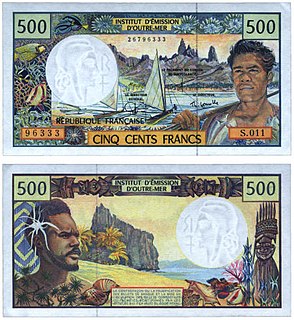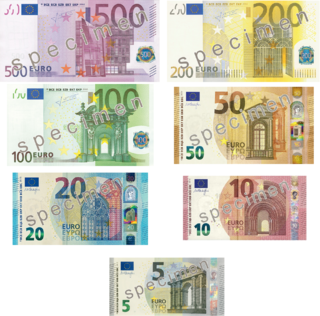
The CFP franc is the currency used in the French overseas collectivities of French Polynesia, New Caledonia and Wallis and Futuna. The initials CFP originally stood for Colonies Françaises du Pacifique. This was later changed to Communauté Financière du Pacifique and then to the present term, Change Franc Pacifique. The ISO 4217 currency code is XPF.

The Syrian pound or Syrian lira is the currency of Syria and is issued by the Central Bank of Syria. The pound is subdivided into 100 qirsh, although coins in qirsh are no longer issued.
The franc is the currency of the Democratic Republic of the Congo. It is subdivided into 100 centimes.

The ariary is the currency of Madagascar. It is subdivided into 5 iraimbilanja and is one of only two non-decimal currencies currently circulating. The names ariary and iraimbilanja derive from the pre-colonial currency, with ariary being the name for a silver dollar. Iraimbilanja means literally "one iron weight" and was the name of an old coin worth 1⁄5 of an ariary.

The Belgian franc was the currency of the Kingdom of Belgium from 1832 until 2002 when the Euro was introduced. It was subdivided into 100 subunits, known as centiemen (Dutch), centimes (French) or Centime (German).

The Djiboutian franc is the currency of Djibouti. Its ISO 4217 currency code is DJF. Historically, it was subdivided into 100 centimes.
The Franc was the currency of the Anglo-French Condominium of the Pacific island group of the New Hebrides. It circulated alongside British and later Australian currency. The New Hebrides franc was nominally divided into 100 Centimes, although the smallest denomination was the 1 franc. Between 1945 and 1969, it was part of the CFP franc.

The dirham is the currency of Morocco. It is issued by the Bank Al-Maghrib, the central bank of Morocco. It is subdivided into 100 centimes.
The franc was the currency of Algeria between 1848 and 1964. It was subdivided into 100 centimes.

The Central African CFA franc is the currency of six independent states in Central Africa: Cameroon, Central African Republic, Chad, Republic of the Congo, Equatorial Guinea and Gabon. These six countries have a combined population of 48.0 million people, and a combined GDP of US$88.2 billion.

The franc was the currency of Tunisia between 1891 and 1958. It was divided into 100 centimes (صنتيم) and was equivalent to the French franc.
The daler was the currency of the Danish West Indies between 1849 and 1917, and of the United States Virgin Islands between 1917 and 1934.
The Ruanda-Urundi franc was a currency issued for the Belgian mandate territory of Ruanda-Urundi in East Africa between 1960 and 1964. The currency replaced the Belgian Congo franc which had also circulated in Ruanda-Urundi from 1916 until 1960 when the Belgian Congo became independent, leaving Ruanda-Urundi as the sole Belgian colonial possession in Africa. With the independence of Rwanda and Burundi in 1962, the shared Ruanda-Urundi franc continued to circulate until 1964 when it was eventually replaced by two separate national currencies.
The franc is the currency of New Caledonia and Wallis and Futuna. It is subdivided into 100 centimes. Since 1945, it has been part of the CFP franc.
The franc is the currency of French Polynesia. It is subdivided into 100 centimes. Since 1945, it has been part of the CFP franc.
The franc was the currency of French Guiana until 2002. The French franc circulated alongside banknotes issued specifically for French Guyana between 1888 and 1961 and notes issued for French Guyana, Guadeloupe and Martinique between 1961 and 1975.

The franc was the currency of Guadeloupe until 2002. It was subdivided into 100 centimes.
The franc was the currency of Martinique until 2002. It was subdivided into 100 centimes. The French franc circulated, alongside banknotes issued specifically for Martinique between 1855 and 1961 and notes issued for Martinique, French Guiana and Guadeloupe between 1961 and 1975.
The franc was the currency of French Equatorial Africa. The French franc circulated, together with distinct banknotes from 1917 and coins from 1942. It was replaced by the CFA franc in 1945.


















